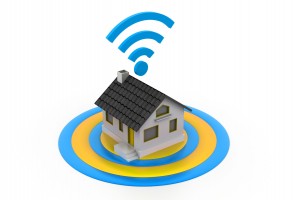Securing Home Wi-fi network
We all like convenience, don’t we? Rubbing sticks together to make fire? No thank you, we much prefer pushing a button on our microwave to warm up our leftover mac and cheese. Write a letter? With a stamp? And all the hassle of writing in the address? Hmmm, no, I think I’ll just tell my smartphone to shoot off a quick text.
Access the Internet through an ethernet cord at my desk?
But convenience sometimes comes with risk. So it is with home wireless networks. By broadcasting your network connection throughout your home, you may be inadvertently opening yourself up to security concerns that were avoided when you plugged your Ethernet cord into the wall.
For example, unless you’ve taken precautions, your neighbors may be able to catch your signal and access the Internet from their devices over your network. You are, of course, still paying for the service and their use of it may slow down your connection. Being the gracious person that you are, you might not mind this inconvenience, but did you know that their online activity – be it ignorant, illicit, or illegal – would now be traced back to your door?
Believe it or not, that’s just the start of potential problems an insecure home network could cause you. Many of the dangers associated with pubic wifi can be transferred to your own living room if your wireless network is insecure. Your network stealing neighbor – or maybe just the guy who parks his car near enough to your home to catch the signal – can also access the information on any device that uses that network. So every time you use a password to log into your bank account…. Or write those sensitive business emails…. Or store your tax documents…. Yep, that’s right. On an insecure home network, your data is anything but safe.
So what do you do? Here are some tips (and some links) to help you better secure your home wireless network:
- Change your router’s default settings: A new router will come with several default settings. One of these is the password needed to log in and change the settings on the router itself. Obviously, this default password is public knowledge and could be used by someone else to change your settings to their own advantage. Once you’ve logged in the first time during setup, change this default password. You should also change other default settings like the name of your network (also known as the SSID) and, if it is enabled, you should disable remote administration/management. This would allow you to manage your network through the Internet when you are away from home, but unless you have a good reason to enable it, it’s just one more door a hacker can come through.
- Enable the firewall and the best available encryption: Check to make sure your router uses WPA or, even better, WPA2 encryption and that the encryption is enabled. Older WEP is no longer effective, so don’t use a router that only provides this type of security. Also, make sure your router’s firewall rules are enabled: Firewall rules prevent your router from being accessed remotely from the internet. Like a lock on your front door, the firewall prevents someone from getting in while still allowing you to get out to the internet.
- Change your router’s default SSID and disable broadcast of SSID: Your network name is called its SSID. This is the name that comes up when you are searching for your network (you’ll notice that as you search for your own network, the SSIDs of other nearby networks sometimes come up as well). First, make sure you change the default SSID name to something unique (in addition to more obvious benefits, this protects your device from accidentally connecting to another wireless router with the same SSID as your own). Second, you can prevent your own SSID from being broadcast publicly. This means that you will have to manually search for it on your own devices the first time you connect (as you will know the name to search for) and that others nearby won’t see your network name when they search for a wireless connection.
- Update your router’s firmware when you first set up your network and regularly afterwards: As security threats evolve, updates are made to the firmware to meet the new threats. If you’re not updated, you are left vulnerable. If you get an advisory from your ISP or your device provider take it seriously and update your router as soon as possible.
These are some of the most common and straightforward steps you can take to secure your home wireless network. It needs to be said that these do not provide 100% security, but they do protect you from common attacks and prevent you from being an easy target. If you want to make your wifi security even tighter, follow the links below to additional articles with further – and in some cases more technical – security measures.
“Home Networking Explained: Keep Your Network Secure” – http://www.cnet.com/how-to/home-networking-explained-part-6-keep-your-network-secure/
“Protecting Your Wireless Network” – https://www.fcc.gov/guides/protecting-your-wireless-network
“How to Set Up and Configure Your Wireless Router” – http://www.pcmag.com/article2/0,2817,2375207,00.asp
